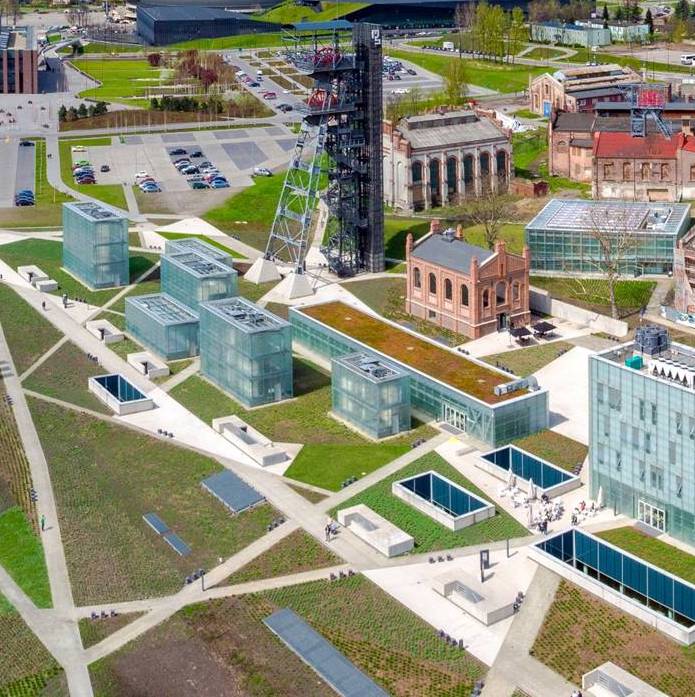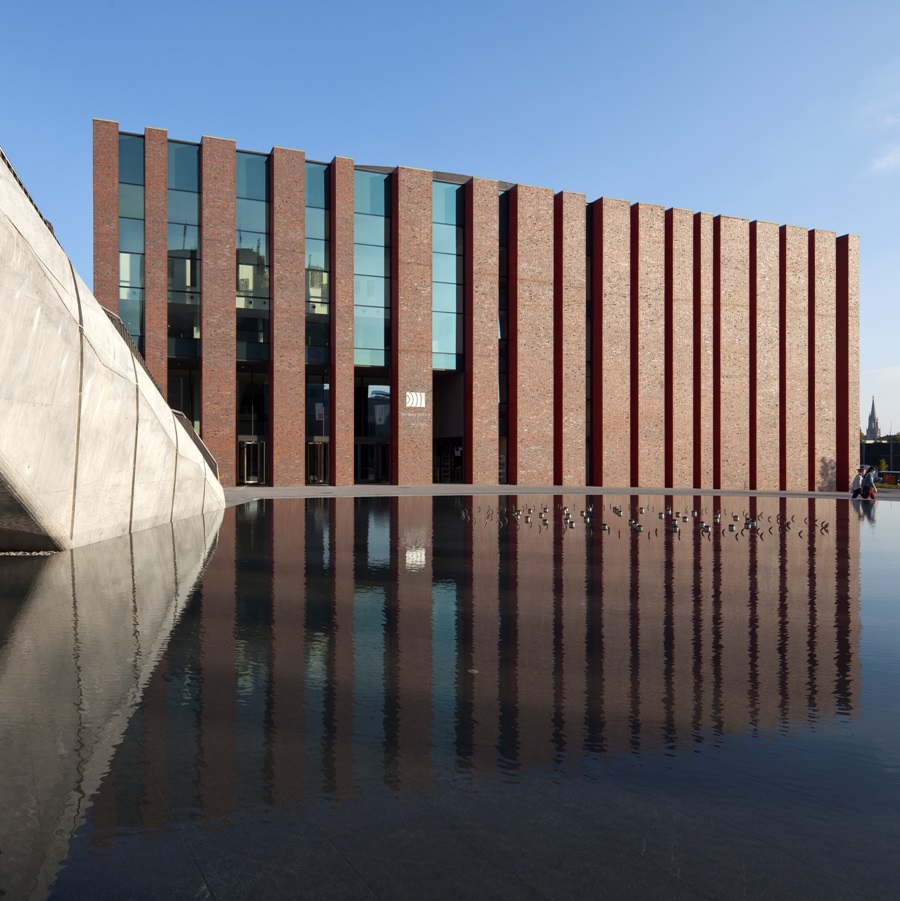Home » Katowice – Host city » Culture
Culture
Katowice is an ever-bustling city in terms of culture. Many famous and recognised artists were born and created their works here, and the cultural activities offer a wide array of events fostering the city’s heritage and setting new trends.

Silesian Museum | Photo: The University of Silesia material
Culture
Katowice’s myriad of cultural events is the apple of over 20 municipal and voivodeship cultural institutions’ eyes; they make sure the calendar brims with concerts, festivals, film reviews, meetings, workshops and other fascinating events.
Read also:
The most prominent institutions
Seat of the Polish National Radio Symphony Orchestra
Founded in 1935, the Polish National Radio Symphony Orchestra in Katowice is one of the most prominent symphony orchestras in Poland and one of the most versatile cultural institutions in terms of their operation. The list of authors who collaborated with the Orchestra includes many outstanding Polish composers, e.g. Witold Lutosławski, Wojciech Kilar, Henryk Mikołaj Górecki and Krzysztof Penderecki. After the new Seat was opened within the Culture Zone in 2014, the Polish National Radio Orchestra entered a new era; the modern and breathtaking building is one of Poland’s largest concert and recording complexes. The building combines history with modernity. The bricks used for construction allude to the Nikiszowiec district, and the top-notch acoustics and equipment of the interiors create the perfect venue for art music, jazz, pop and hip-hop concerts.
More at: https://nospr.org.pl/
Silesian Freedom and Solidarity Centre
The basic goal of the Centre is conducting the exhibition devoted to the strike and the ‘pacification’ of KWK Wujek Coal Mine. The Museum is located in a historic building by the Cross-Monument, at the crossroads of ul. Józefa Gallusa and ul. Wincentego Pola. The over-a-century-old building used to be a clothing warehouse. The Centre communicates knowledge about this disturbing event in a modern way. Apart from that, the Centre offers a series of podcasts available via the website and a range of workshops. The DIY workshops may be especially worthwhile for people who have not lived in the communist era and teach you how to make a stamp, an envelope, a badge, or print a magazine at home. Through acquiring new skills, participants learn history and even travel back in time to an underground publishing house from the 1980s.
More at: https://scwis.pl/en
Silesian Library
Operating for over 100 years, the Library consists of three seats. The main seat—Silesia’s largest library—is located on ul. Rady Europy and offers a wide selection of volumes. The building features reading rooms and the Open Zone, where you can find the latest publications, also in languages other than Polish. It is the main hub for ‘Meet the Author’ sessions and literary workshops and events. The building at ul. Francuska 12 hosts three units: the House of Education, organising classes for children and adolescents; the Intimate Gallery, displaying contemporary art exhibitions; and the Institute of Architecture Documentation, storing substantial collections concerning the Silesian architecture and organising various science communication events, e.g. architecture walking tours. The building at ul. Ligonia 7 hosts the Bibliotherapy Department, offering activities for seniors and people with special needs, and the Regional Research Institute organising events and conducting publishing activities concerning Upper Silesia’s history and culture.
More at: https://bs.katowice.pl
Silesian Philharmonic
The Silesian Philharmonic has been established to foster and cultivate the musical culture in the region, Poland and abroad. It organises concerts, carries out educational activities (concerts, auditions, workshops), engages in publishing and releasing (records, videos, books, concert programmes, and commemorative prints), and science communication (exhibitions, scenario-based games, contests and competitions). Among many activities organised by the Philharmonic, two recurring events are particularly popular: Grzegorz Fitelberg International Competition for Conductors and the International Days of Henryk Mikołaj Górecki. Henryk Mikołaj Górecki, the now patron of the Silesian Philharmonic, was a composer of international fame and reputation; the winner of numerous awards including: first prizes at the Paris Biennial Festival of Youth and the International Rostrum of Composers held at UNESCO headquarters, and the Order of the White Eagle, the highest order of merit of the Republic of Poland.
The Philharmonic goes outside the limits of conventional thinking and concert halls, producing spectacular shows in the Spodek Arena featuring multimedia and pyrotechnic effects. In 2023 alone, the Philharmonic organised, e.g. the Film Music Gala, GAME MUSIC CONCERT and the Hip-hop Symphonic Concert. Each event presented classical music from various aspects, e.g. film, games, or hip-hop.
More at: https://filharmonia-slaska.eu/
Silesia Film
The Silesia Film runs five art-house cinemas: Kino Kosmos, screening classic films and providing film education; Kino Światowid, focusing on European art-house cinema; and Kinoteatr Rialto, recognised for its artistic repertoire; and two cinemas outside Katowice – Kino Janosik in Żywiec and Kino Bałtyk in Racibórz. Each cinema has its own original offer of events and meetings, and film screenings are often combined with talks featuring experts in various fields. Interestingly, Kino Światowid organises screenings of classics, e.g. Pulp Fiction or Top Gun in Silesian, featuring actors from the Silesian Theatre reading the dialogues live. The Silesia Film is also responsible for co-organising film festivals popular in Katowice, e.g. the Ars Independent dedicated to independent cinema and the Silesia edition of the Millennium Docs Against Gravity, a documentary film festival.
It supports film production and distributes films, and—as part of the Silesia Film Commission—recommends and promotes regional locations among filmmakers. Additionally, the Silesia Film manages the Silesian Film Archive, the only regional film library in Poland.
More at: https://silesiafilm.com/
Cultural Institution Ars Cameralis Silesiae Superioris
Autumn in Katowice would not have been the same without the annual Ars Cameralis Festival. Concerts, exhibitions, film screenings and meetings with artists from around the world are famous and popular across the entire Poland. Formed in 1994, Ars Cameralis has been all about interdisciplinarity, diversity and the hottest phenomena in contemporary culture. Apart from organising the Festival, the Institution promotes Silesian art and culture abroad. The most spectacular manifestations of this field of activity were the presentations of various achievements of the Silesian Region at the World EXPO (Hanover 2000, Zaragoza 2008), and during the Silesian Days organised in North Rhine-Westphalia, Bratislava, Vienna, Dresden, Budapest, Gothenburg, Miskolc, Berlin and the Art Week in Beloeil Ars Cameralis has organised exhibitions and projects promoting artists originating from Silesia (including exhibitions in Milan, at MoMA Museum of Modern Art in New York or during the Venice Biennale), as well as the presentation of the North Rhine-Westphalia Region in Upper Silesia.
More at: https://arscameralis.pl/
Silesian Museum
A must-see during your stay in Katowice is visiting the Silesian Museum. The headquarters of the institution itself says a lot about the city – next to the former mine shaft and industrial buildings, a glass-walled, modern building has been constructed. Here, modernity meets tradition, both outside and inside the building. The exhibitions organised here stand out in terms of innovative exhibition techniques and current topics. At the same time, permanent exhibitions are devoted primarily to popularising the heritage of the region and its artists. These include the gallery of Silesian sacred art, the gallery of non-professional art, and the exhibition ‘The Light of History. Upper Silesia Over the Centuries.’ Exhibition spaces, educational rooms, an auditorium and a library with a reading room are located underground. During your visit, be sure to enter the terrace of the 40-metre-high observation tower with the ‘Warszawa II’ lift shaft. This is a unique opportunity to see the panorama of Katowice, especially from a place deeply intertwined with its cultural heritage. The museum also houses MOODRO Bistro & Cafe, where you can try local cuisine.
More at: https://muzeumslaskie.pl/
Wojciech Korfanty Regional Institute of Culture
Wojciech Korfanty was one of the most important figures in the history of Upper Silesia. A politician and activist, he was a member of the German parliament and served as the deputy prime minister of Poland. He played a crucial role in the annexation of Silesia to Polish lands in 1921. The institute is primarily concerned with the protection and dissemination of cultural heritage values regarding the Silesian Uprisings and the political and journalistic activities of Wojciech Korfanty. The cultural identity of the region is nurtured through educational, documentational, informational and publishing activities. They are not, however, limited only to history – the series ‘Codes of Culture’ involves meetings with the most important representatives of Katowice culture. The institute is also one of several dozen entities in Poland accredited under the Erasmus+ 2021-2027 programme.
More at: https://instytutkorfantego.pl/
Silesian Theatre
Museum of Katowice Archdiocese
Are you interested in sacred art? You will find many fascinating collections in the Museum of Katowice Archdiocese. Located near the impressive Christ the King’s Cathedral in Katowice, the Museum collects, stores and shares objects of religious art, souvenirs, secular objects coming from parishes and gifts, and items having any connection with the region and the history of the diocese. Of particular interest may be historical icons and paintings from the Renaissance and the late Middle Ages. The Museum is also home to the ‘Fra Angelico’ Art Gallery, a place of regular temporary exhibitions, meet-the-artist sessions and an open dialogue between the Church and art.
More at: https://muzeum.katowicka.pl/
BWA Contemporary Art Gallery
Katowice City of Gardens – Cultural Institution
The Institution organises various artistic events (mainly in Upper Silesia), and implements projects in the fields of music, film, design, visual arts, education, ecology, theatre and sports. The list of the most important regularly organised events include: Katowice JazzArt Festival, Katowice Anniversary Celebrations, the Gardens of Sounds World Music Festival and the Ars Independent Film Festival. One of the noteworthy initiatives is the innovative Medialab Katowice project, carrying out workshops, lectures and presentations on audiovisual culture. Its participants may acquire digital competencies and develop creativity by experimenting with new technologies.
The headquarters are located in the vicinity of the Silesian Parliament in a characteristic white building with the word ‘lub’ repeated many times on its exterior. This is a project by Stanisław Dróżdż, a famous Polish artist and poet.
More at: https://miasto-ogrodow.eu/
Museum of Katowice History
Located in several buildings, the Museum protects collections related to Katowice’s historical and artistic heritage. The Museum is home to 26 portraits by Stanisław ‘Witkacy’ Witkiewicz, one of the most significant Polish artists. Individual sections of the museum present the works of local authors. The Theatre and Film Department shows the achievements of outstanding theatre and film couple, Barbara Ptak (a costume designer) and Stanisław Ptak (an actor). On the other hand, the Graphic Arts Department organises exhibitions of graphic arts by Polish and foreign artists; above all, it focuses and displays the works of Paweł Steller, dubbed by Western critics as ‘Polish Dürer’, the most outstanding Silesian graphic artist. The City Ethnology Department collects documents on research and presentation of the working class life, customs and traditions over the centuries; it is home to an intriguing collection of Silesian painters of the so-called Janów Group. This art depicts the regional culture in a unique way.
More at: https://www.mhk.katowice.pl/
Silesian Puppet and Actor Theatre ‘Ateneum’
Founded in 1945, ‘Ateneum’ is one of the oldest puppetry theatres in Poland. Addressed primarily to children, it stages classic fairy tales and contemporary pieces. The spectacles involve the use of the means of puppet theatre and its connections with the live stage. The International Puppet Theatre Festival “Katowice – for Children” has been perfectly complementing the proposals not only for the youngest since 2002. The Theatre is home to the Ateneum Gallery, an exhibition space exhibiting primarily the works of artists associated with the Academy of Fine Arts and Design in Katowice. In 2016, ‘Ateneum’ Theatre was awarded the Bronze Gloria Artis Medal for Merit to Culture.
More at: https://ateneumteatr.pl/
Branches of City Cultural Centres
Katowice is home to 5 City Cultural Centres located in different parts of the city. Their major goal is to unite, support and engage local communities. People may gain new skills and meet new people, all as part of workshops, training sessions, meetings and exhibitions The Centres are closest to people, and the people who enjoy their offer are not merely the centres’ audience but become their part and influence the carried out activities. Their offer is addressed to children, adolescents, adults and seniors individually, depending on their cultural competencies and needs. The institutions put particular effort into accessibility and inclusiveness.
‘Koszutka’ City Cultural Centre – https://www.mdkkoszutka.pl/
‘Bogucice-Zawodzie’ City Cultural Centre – https://mdkbogucice-zawodzie.pl/
‘Ligota’ City Cultural Centre – http://www.mdkligota.pl/
‘Południe’ City Cultural Centre – https://www.mdkpoludnie.com/
‘Szopienice-Giszowiec’ City Cultural Centre – https://mdk.katowice.pl/
Public Library
The Public Library is a library and a community centre. Consisting of 38 branches scattered throughout Katowice, the facility provides book collections and organises events dedicated to residents. The program of workshops and meetings is devoted to literature, but also to socially important topics – ecology, identity and city life. The Library’s diverse offers forest bathing, art classes, and meet-the-author sessions with popular writers. Libraries foster equal access to culture; thus, during the pandemic, they introduced book deliveries to people’s homes, which has been especially appreciated by seniors and people with disabilities.
The beating heart of Katowice is the Culture Zone, built on the site of the closed KWK ‘Katowice’ coal mine. The Zone consists of the Spodek Arena, the International Congress Centre, the seat of the Polish National Radio Symphony Orchestra (NOSPR), the Silesian Museum, and the International Congress Centre.
Since 2015, Katowice has been part of the UNESCO Creative Cities Network as the UNESCO City of Music. The city is home to over 20 concert halls and 30 music clubs. Katowice is the host city of some of the most important music events in Europe, including: Off Festival, Tauron. Nowa Muzyka, Gardens of Sounds World Music Festival, Rawa Blues Festival, Ars Cameralis Festival, Katowice JazzArt Festival, Silesian Jazz Festival and Mayday.
More at: https://mbp.katowice.pl/



